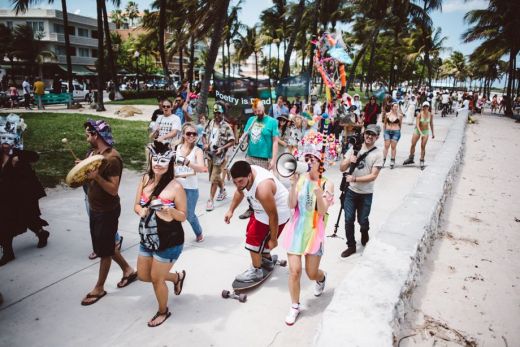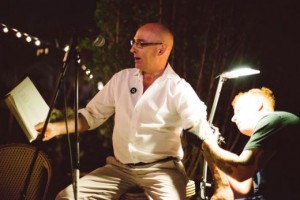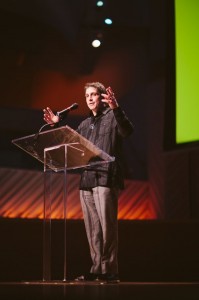- Los Jaichackers: Far From the Standard at The Standard

- Bubbles in Paradise? Stay Tuned.
QATAR, DUBAI, ABU DHABI, SHARJAH
A Shout in the Street: O, Miami’s Takeover of the County
Nick Mencia

Dead Poets Parade.
It was the second month-long poetry festival I have ever seen, the first being O, Miami 2011. While a few other month-long poetry festivals occur elsewhere, Boston for one, I don’t think any others take such a loose and whimsical approach to the structure of what a poetry festival can be. Scrolling over The Waste Land, its pretty clear T.S. wasn’t writing about Miami. The month was not what I would call cruel, not in weather, or otherwise: just thirty days of poetry and performance spanning several mediums taking place across the entire county. It was stunning to see how a month-long event could infiltrate such an immense land space, and an even more vast landscape of collective consciousness. O, Miami’s mission is to allow every single person in Miami-Dade County to encounter a poem in the month of April, and while they probably came up just a bit short, it was not for lack of effort. There were airplanes towing succinct lines across the clear blue sky, parking tickets with love poems set delicately under the windshield wipers of cars, beer coasters running slightly with ink, kamikazed onto bar tops, and numerous poems handed out to strangers, as well as readings, radio broadcasts, TV spots, dance performances, poetry contests, poetry parades, Cuban food buffets, movies, and marching bands. I heard a Miami poet who read for President Obama at his Inauguration, and a middle-aged woman who had never written a poem before this month, on the same stage on the same night.
DAY 1 — Ferocious rain makes an island out of the Palacio de los Jugos on Flagler and 57th. We eat from platters of Cuban food, chicharones that taste like marijuana: smoky, distinctive, salty and sweet. There are typewriters in place for people to write poems. A man sucks the syrupy and brownish-yellow water out of the parking lot with an elephant hose. Behind the counter, the juices provide color to the very uncharacteristically gray day: sunny pineapple, lipstick watermelon, luscious orange. The guava juice is the best thing I’ve ever tasted.
DAY 2 — Ocean Drive overflowing with lost people. Scott Cunningham reads Borges to confused onlookers wearing colored-plastic sunglasses and draped in striped beach towels. It happens every day this month. Different poets, the same spot. From the Betsy Hotel Soapbox, the director reads a poem of his own “O, 1987” a poem lamenting everything that was lost that year. The bleak vapidity of Ocean Drive lifts, just for a second, before returning to itself.

Tom Healy getting an O, Miami tattoo.
DAY 17 — There is a bus tour. Nothing really happens on the bus besides the dispensing of bags filled with poems, pictures, and a small bottle of booze, labeled 99-something-or-other that sits temptingly at the bottom. The guide says he’ll be leading this drunken boat down the back alleys of South Beach. We see dead arches, dumpster nooks, hobo holes, a couple of guys playing football watching us curiously, a banyan tree fighting with the ground, an animal beast mural, the facade of a beautiful museum, a woman in gypsy garb sitting on a pillow outside of a playground reading poetry, stray cats and the man who is feeding them. No pictures please. We hear poems by O’Hara, Rimbaud, Neruda, and the guide himself. He tells us about the immortal elephant of South Beach. We leave knowing there is potential in the alley; did we know this all along?

Richard Blanco at O, Miami. Photos by Gesi Schilling.
DAY 28 — The last day. The Poetry is Dead Parade is intended to be a funeral procession in reverse, to reawaken not only dead poets, but for the people who needed it, poetry itself. There were plenty of confused onlookers, as there were at other events throughout the month. Marchers wore large signs with words like whilst, heron, expired, therefore, how, and other trinkets that could be strung together as we walked. Many were dressed as expired poets—Walt Whitman, Jose Marti, Edgar Allan Poe, two Miguel Pineros, and three Emily Dickinsons, among others. Some were dressed for a funeral, which looks unholy on a sunny Sunday afternoon on Ocean Drive. Still others were dressed in random funky neon, banging pots and pans, riding in a rickshaw, or carrying a huge neon dream catcher staff. Along the way there was poetry read, a knife fight between the two Pineros, a destruction of a paper boat with water balloons, and much chanting, banging, and general merry-making.
***
Before a poem is a poem, it is nothing but an idea. An idea, before put into practice, is nothing. Poetry dances on the line between the tangible and intangible world. O, Miami’s goal was to have every resident of Miami-Dade encounter a poem. Do they already? Some would say that poetry is everywhere. It’s in the air, in the water, on the trees and buildings, on the billboards, and on the faces of strangers we pass on the street. This is perhaps too simplistic. Before these images can become poems, they need people to acknowledge them, reflect upon them, and put them into words. While giving people ample opportunities to experience poetry in its more finished form, O, Miami also encouraged people to see the potential in their surroundings, and upon doing so, mediate on them and create something from them. In this way, what O, Miami was trying to do was to make poets out of everyone it encountered. O, Miami confronts people with a way of seeing what was always there. Whether this is a glass of guava juice at the palace of juices, on an island of dry, while water from a tropical storm cascades all around you, whether it’s watching people write words on a blackboard with the music of a marching band surrounding you in the middle of little Haiti, wandering the dark corners of your city at dusk, whether it’s watching two dancers enveloped in construction paper pirouette across a parking lot downtown while you sit on a pillow in a warehouse downtown, no matter what it is, O, Miami makes it a little more tangible for those of us who like to think we deal with the world in concretes. The truth is, we don’t know. We are left with Didion’s peculiarity and warp, peculiarity being a way of classifying a thought about something you see, and warp being a physical process of shifting form. These two poles show the gap between the immaterial and material world. This is the place where poetry can live; it’s a place that has been around at least as long as the buildings, and might just outlast them.









